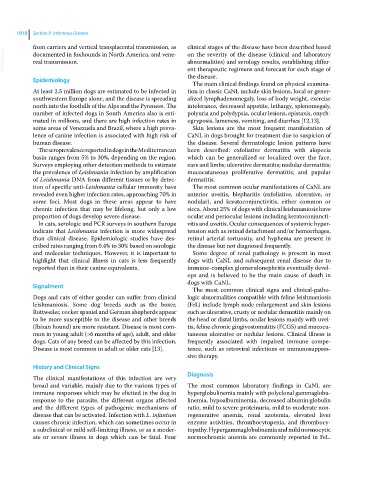Page 1072 - Clinical Small Animal Internal Medicine
P. 1072
1010 Section 9 Infectious Disease
from carriers and vertical transplacental transmission, as clinical stages of the disease have been described based
VetBooks.ir documented in foxhounds in North America, and vene- on the severity of the disease (clinical and laboratory
abnormalities) and serology results, establishing differ-
real transmission.
ent therapeutic regimens and forecast for each stage of
the disease.
Epidemiology
The main clinical findings found on physical examina-
At least 2.5 million dogs are estimated to be infected in tion in classic CaNL include skin lesions, local or gener-
southwestern Europe alone, and the disease is spreading alized lymphadenomegaly, loss of body weight, exercise
north into the foothills of the Alps and the Pyrenees. The intolerance, decreased appetite, lethargy, splenomegaly,
number of infected dogs in South America also is esti- polyuria and polydypsia, ocular lesions, epistaxis, onych-
mated in millions, and there are high infection rates in ogryposis, lameness, vomiting, and diarrhea [12,13].
some areas of Venezuela and Brazil, where a high preva- Skin lesions are the most frequent manifestation of
lence of canine infection is associated with high risk of CaNL in dogs brought for treatment due to suspicion of
human disease. the disease. Several dermatologic lesion patterns have
The seroprevalence reported in dogs in the Mediterranean been described: exfoliative dermatitis with alopecia
basin ranges from 5% to 30%, depending on the region. which can be generalized or localized over the face,
Surveys employing other detection methods to estimate ears and limbs; ulcerative dermatitis; nodular dermatitis;
the prevalence of Leishmania infection by amplification mucocutaneous proliferative dermatitis; and papular
of Leishmania DNA from different tissues or by detec- dermatitis.
tion of specific anti‐Leishmania cellular immunity have The most common ocular manifestations of CaNL are
revealed even higher infection rates, approaching 70% in anterior uveitis, blepharitis (exfoliative, ulcerative, or
some foci. Most dogs in these areas appear to have nodular), and keratoconjunctivitis, either common or
chronic infection that may be lifelong, but only a low sicca. About 25% of dogs with clinical leishmaniosis have
proportion of dogs develop severe disease. ocular and periocular lesions including keratoconjuncti-
In cats, serologic and PCR surveys in southern Europe vitis and uveitis. Ocular consequences of systemic hyper-
indicate that Leishmania infection is more widespread tension such as retinal detachment and/or hemorrhages,
than clinical disease. Epidemiologic studies have des- retinal arterial tortuosity, and hyphema are present in
cribed rates ranging from 0.4% to 30% based on serologic the disease but not diagnosed frequently.
and molecular techniques. However, it is important to Some degree of renal pathology is present in most
highlight that clinical illness in cats is less frequently dogs with CaNL and subsequent renal disease due to
reported than in their canine equivalents. immune‐complex glomerulonephritis eventually devel-
ops and is believed to be the main cause of death in
dogs with CaNL.
Signalment
The most common clinical signs and clinical‐patho-
Dogs and cats of either gender can suffer from clinical logic abnormalities compatible with feline leishmaniosis
leishmaniosis. Some dog breeds such as the boxer, (FeL) include lymph node enlargement and skin lesions
Rottweiler, cocker spaniel and German shepherds appear such as ulcerative, crusty or nodular dermatitis mainly on
to be more susceptible to the disease and other breeds the head or distal limbs, ocular lesions mainly with uvei-
(Ibizan hound) are more resistant. Disease is most com- tis, feline chronic gingivostomatitis (FCGS) and mucocu-
mon in young adult (>6 months of age), adult, and older taneous ulcerative or nodular lesions. Clinical illness is
dogs. Cats of any breed can be affected by this infection. frequently associated with impaired immune compe-
Disease is most common in adult or older cats [13]. tence, such as retroviral infections or immunosuppres-
sive therapy.
History and Clinical Signs
Diagnosis
The clinical manifestations of this infection are very
broad and variable, mainly due to the various types of The most common laboratory findings in CaNL are
immune responses which may be elicited in the dog in hyperglobulinemia mainly with polyclonal gammaglobu-
response to the parasite, the different organs affected linemia, hypoalbuminemia, decreased albumin:globulin
and the different types of pathogenic mechanisms of ratio, mild to severe proteinuria, mild to moderate non-
disease that can be activated. Infection with L. infantum regenerative anemia, renal azotemia, elevated liver
causes chronic infection, which can sometimes occur in enzyme activities, thrombocytopenia, and thrombocy-
a subclinical or mild self‐limiting illness, or as a moder- topathy. Hypergammaglobulinemia and mild normocytic
ate or severe illness in dogs which can be fatal. Four normochromic anemia are commonly reported in FeL.

